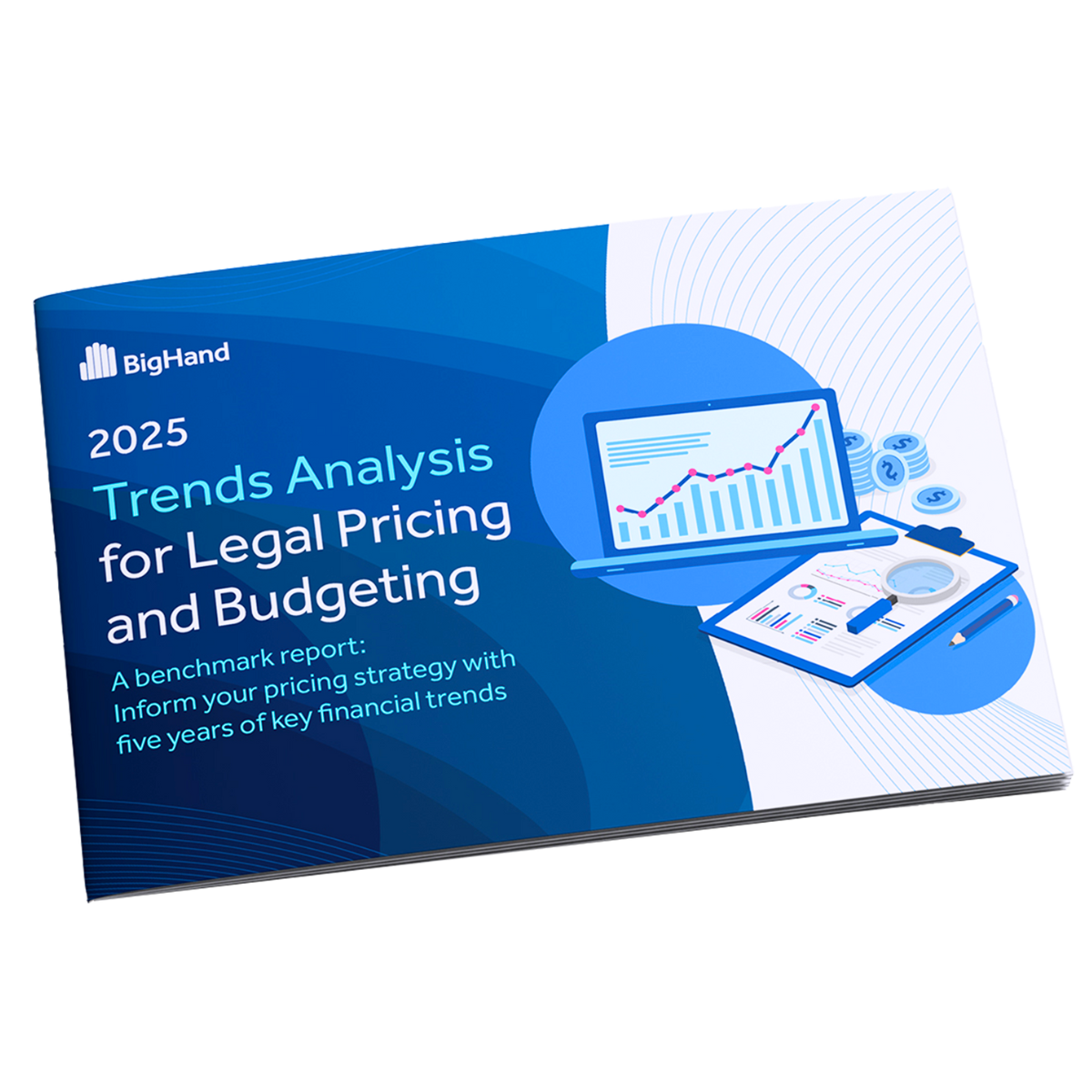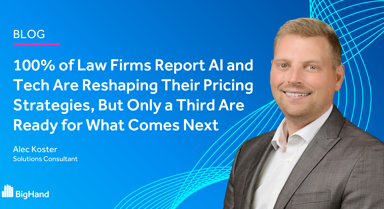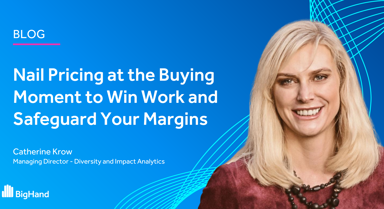I recently spent two days at LVNx in Chicago, and it reminded me why I love these events: the chance to sit down with so many of our law firm customers, hear what’s really happening on the ground, and gain a sense of where the market is moving.
Several of the sessions, including Beyond the Math: Essential Skills to Price Legal Services in the AI Era, really got me thinking. It didn’t focus on technology or tools; it focused on what truly matters to clients: clarity, confidence, and commercial partnership, something smart firms have been chasing for years. Across all the sessions, common themes emerged, many of which fed this post.
After nearly 30 years in legal, I’ve seen plenty of trends come and go, but this one is different. From my conversations with our customers, it’s clear that AI isn’t just an efficiency play; it’s a catalyst forcing firms to redefine value, profitability, and pricing governance along with countless considerations around liability, security, and reputation.
BigHand’s 2025 Legal Pricing and Budgeting Trends Analysis backs up what I’m hearing every week: firms that operationalize AI-driven insight, transparent pricing, and commercial alignment now will lead for the long term. Those that don’t risk eroding client trust and margin discipline.
Here’s what I believe legal CFOs, pricing directors, and firm leaders need to focus on, and how we’re helping firms make that shift at BigHand.
1. AI will touch 80% of legal spend but client trust remains the currency of choice
The stat hit hard: AI could influence up to 80% of legal spend. But the differentiator won’t be who deploys AI first; it’s who uses it to deliver measurable value to their clients. By the way, it won’t reduce the effort by 80%!
In my conversations with law firm leaders and corporate clients, I hear the same thing: “Don’t just tell me you’re using AI, show me how it helps me, and make me aware of any risk.”
Clients want transparency and proof of efficiency, not AI headlines. While firms experiment with tools, many can’t yet show how those efficiencies translate into pricing adjustments, improved delivery economics, or potentially better outcomes/client experience.
This is where leadership and data come together. Technology should help firms translate AI-driven efficiency into client value - by tracking performance, comparing outcomes, and demonstrating transparency. BigHand’s solutions are designed to give firms the data foundation to make that possible.
What this means for law firms:
- Don’t lead with hype, lead with evidence. Show faster delivery, lower rework, and improved predictability. Tell a story with data-driven proof points.
- Use analytics to quantify efficiency and reinvest those gains in stronger client partnerships.
- Trust, communication, and transparency remain your strongest retention tools.
Suggested action: Review your client pitch materials and make sure they clearly articulate how AI drives measurable value, and leverage a dedicated legal pricing and budgeting tool to demonstrate that proof.
2. Understand the difference between pricing and costing
The LVNx panel nailed it: pricing is perception; costing is fact.
Too many firms still price based on what it costs them to deliver the work, and that’s backwards. Clients don’t buy inputs; they buy outcomes, risk mitigation, and peace of mind. From my conversations with CFOs and pricing directors, I know how challenging it is to bridge that gap.
What this means for you:
- Stop pricing purely from the general ledger. Use real-time data to understand profit and performance across matters, clients, and practice groups.
- AI that reduces cost doesn’t mean a lower price if the client’s value hasn’t changed. Use visibility to protect margin and demonstrate fairness.
- Equip pricing teams with analytics that facilitate agility throughout the matter lifecycle.
Suggested action: Ask “What’s at stake for this client?” at the start of every conversation, then use data from tools like BigHand Matter Pricing and BI dashboards to back it up with credible numbers.
3. Segment “playbook” and “strategic” matters and price them differently
Not every matter is impacted by AI in the same way, and I’ve seen this first-hand in my conversations with firms adopting new pricing frameworks.
Playbook matters, such as due diligence or contract review, are ideal for AI acceleration. Many firms tell me they’re already seeing 40 to 60 percent faster turnaround using automation. Strategic or complex matters, such as litigation strategy or M&A, are where human judgment remains the premium. Here, AI supports decision-making and pattern recognition but doesn’t replace the partner’s expertise.
What this means for you:
- For playbook matters: price for efficiency and certainty. Use fixed or capped fees tied to delivery gains, explain to your clients how you are bringing them the same outcome for a more aggressive price. Show them, tell them, and then tell them again!
- For complex matters: price for strategic value and risk mitigation. Use AI-enabled data to justify premium pricing through insight, not intuition.
- Don’t price both categories the same way. BigHand data shows firms that segment matter types achieve up to 18 percent higher realization.
Suggested action: Audit your matter portfolio. Identify where efficiency gains are possible and where expertise still commands premium value.
4. Shift decisively to value-based pricing
This is the big one, and the conversation I have most often with our customers.
Value-based pricing means anchoring fees to client outcomes, not internal effort. As one pricing director recently told me, “AI has made efficiency table stakes; value is what we’re really competing on now.”
BigHand’s 2025 analysis found that 79 percent of firms see the opportunity for more value-based billing, but only 31 percent have systems in place to measure it. That’s the competitive gap.
Legal tech bridges that gap, giving firms visibility into forecast versus actual margin, client budget alignment, and profitability at every stage. When combined with a powerful BI solution, CFOs can monitor realization, recovery, and client value metrics across the firm.
What this means for you:
- Hourly billing will persist, but it shouldn’t be your default; more and more clients want creative, value-based pricing.
- AFAs need structure, analytics, and governance, not guesswork.
- Equip your lawyers with the commercial confidence and data they need for value-based conversations.
Suggested action: Build a pricing governance framework underpinned by data-driven tools, making pricing a strategic function, not an administrative one.
The Bottom Line
AI is transforming how legal work is delivered and priced, but the fundamentals haven’t changed. From every conversation I’ve had with law firm leaders, one message stands out: clients still buy confidence and partnership, predictability is a not-too-distant third.
The firms that win will use data as their differentiator, combining AI efficiency with BigHand’s pricing, workflow, and analytics solutions to create a continuous feedback loop from scoping to delivery to profitability review.
If you’re a legal CFO or pricing director, now’s the time to act:
- Review your pricing and margin analytics.
- Equip your teams with AI-enabled data visibility.
- Partner with BigHand to build the infrastructure that converts efficiency into profit.
If you’re in firm leadership, elevate your pricing function from back office to boardroom. Give them access to the tools, insights, and authority they need to drive profitability with precision.
AI may reshape 80 percent of legal spend, but trust, transparency, and commercial clarity/consistency will determine who wins the next decade.








